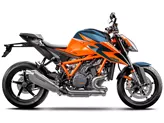Yamaha R1 2016 vs. Ducati 1299 Panigale S 2016

Yamaha R1 2016

Ducati 1299 Panigale S 2016
Vue d’ensemble - Yamaha R1 2016 vs Ducati 1299 Panigale S 2016
The Yamaha R1 2016 and the Ducati 1299 Panigale S 2016 are both powerful and high-performance supersport motorcycles. However, there are several key differences between the two models.
In terms of engine specifications, the Yamaha R1 2016 is equipped with a 998cc engine that produces 200 horsepower and 112.4 Nm of torque. On the other hand, the Ducati 1299 Panigale S 2016 has a larger 1285cc engine that delivers 205 horsepower and 144.6 Nm of torque. This gives the Ducati a slight advantage in terms of power output.
Both motorcycles feature upside-down telescopic fork front suspension and double disk front brakes. They also have similar front tire widths and diameters. However, there are some differences in the rear tire dimensions, with the Yamaha having a 190mm width and the Ducati having a wider 200mm width. Additionally, the wheelbase of the Yamaha R1 is slightly shorter at 1405mm compared to the 1437mm of the Ducati 1299 Panigale S.

Yamaha R1 2016
In terms of chassis, both motorcycles have an aluminum frame. However, the Yamaha R1 features a Deltabox frame, while the Ducati 1299 Panigale S has a monocoque frame. The choice of frame design can have an impact on the handling and overall performance of the motorcycle.
When it comes to weight, the Yamaha R1 2016 has a kerb weight of 199kg with ABS, while the Ducati 1299 Panigale S 2016 is slightly lighter at 190.5kg with ABS. This weight difference may contribute to differences in handling and maneuverability between the two models.
In terms of seat height, the Yamaha R1 has a higher seat height at 855mm compared to the 830mm of the Ducati 1299 Panigale S. This may be a consideration for riders of different heights.
Both motorcycles have a fuel tank capacity of 17 liters, providing a similar range for long rides.

Ducati 1299 Panigale S 2016
In terms of strengths, the Yamaha R1 2016 is praised for its lively handling, high-revving and controllable engine, and excellent electronics package. On the other hand, the Ducati 1299 Panigale S 2016 is lauded for its great electronics package, shift assistant, stunning looks, and impressive speed in the hands of an expert rider.
However, the Yamaha R1 2016 has a weakness in that its shift assistant is only available for upshifting. On the other hand, the Ducati 1299 Panigale S 2016 has been criticized for being exhausting on corner exit, having a narrow rev band, and emitting strong heat radiation to the rear end.
Overall, both the Yamaha R1 2016 and the Ducati 1299 Panigale S 2016 are high-performance motorcycles with their own strengths and weaknesses. The choice between the two will ultimately depend on the rider's preferences and priorities.
Caractéristiques techniques Yamaha R1 2016 par rapport à Ducati 1299 Panigale S 2016
Avantages et inconvénients en comparaison
Avantages et inconvénients en comparaison
Yamaha R1 2016

La fusée high-tech de Yamaha est toujours à la pointe de la technologie en 2016. Radicale, polarisante et fascinante, elle réalise de puissants temps au tour. Elle est plus proche des motos de course que les autres 1000. Entre-temps, personne ne se plaint de l'avant. Sans "M", elle est le meilleur choix pour ceux qui n'ont de toute façon pas besoin d'Öhlins ou le meilleur choix pour ceux qui prévoient de toute façon une transformation sur circuit et qui aiment monter du matériel Öhlins "normal", sans truc électrique.
Ducati 1299 Panigale S 2016

Avec son bicylindre vrombissant et son look divin, elle vole encore la vedette aux autres motos du paddock lors du déchargement. L'ensemble électronique semble parfait, mais le châssis est un peu trop radical. Le V2 ravira les fans, mais risque d'être trop exigeant pour les débutants.
Comparaison des prix Prix moyen du marché Yamaha R1 vs Ducati 1299 Panigale S
There are a few key differences between a Yamaha R1 2016 and a Ducati 1299 Panigale S 2016. In terms of price, the actual average price of a Ducati 1299 Panigale S 2016 is about 30% higher. A Yamaha R1 2016 experiences a loss of 670 USD in one year and 590 USD in two years of ownership. This is offset by a loss of 120 USD and 20 USD for a Ducati 1299 Panigale S 2016. Compared to Ducati 1299 Panigale S 2016 there are more Yamaha R1 2016 bikes available on the 1000PS.de Marketplace, specifically 6 compared to 4. It takes less time to sell a Yamaha R1 with 73 days compared to 93 days for a Ducati 1299 Panigale S. Since model year 2005 1000PS.de editors have written 80 reviews for the Yamaha R1 and 13 reviews for the Ducati 1299 Panigale S since model year 2015. The first review for the Yamaha R1 was published on 4/28/2003 and now has more than 3,900 views. This compares to more than 44,500 views for the first review on Ducati 1299 Panigale S published on 11/3/2014.




















